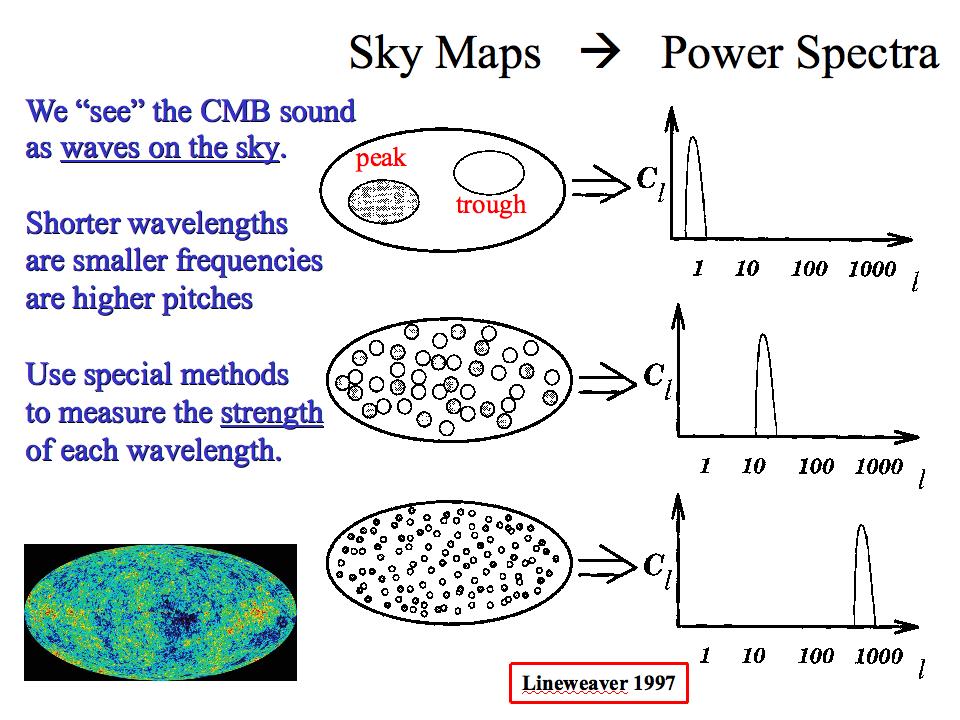
Its all very well showing flute sound spectra, but what about the cosmic sounds? How do we measure their sound spectra, since their periods are way too long for us to measure directly. Instead, we measure a related quantity: wavelength, since this is a close cousin of period. To get the sound spectrum, we just need the relative loudness of each wavelength. There is one further detail. We see the waves up in the sky where it's tricky to estimate their size without also knowing their distance. A convenient shortcut is simply to measure the wavelength in degrees of angle on the sky. One speaks of 2° waves or 40° waves (the latter is huge, the former is about 4 times the diameter of the full moon). Finally, to maintain similarity with normal sound spectra, loudness is plotted against the angular frequency, l, (ell) which is roughly 180/wavelength (in degrees), and provides our measure of pitch. Notice that 1° patches in the CMB have l ~ 180.

|
The above slide, which is adapted from one by Charlie Lineweaver, nicely illustrates all this. Huge long waves show up as small l, medium waves contribute at intermediate l, while tiny waves show up at large l. The currently measured range of l is 2 - 2000. Finally, clever (Fourier) computer methods can scour the CMB map and extract the relative amount of each l, giving the sound spectrum.
And this is what you find:
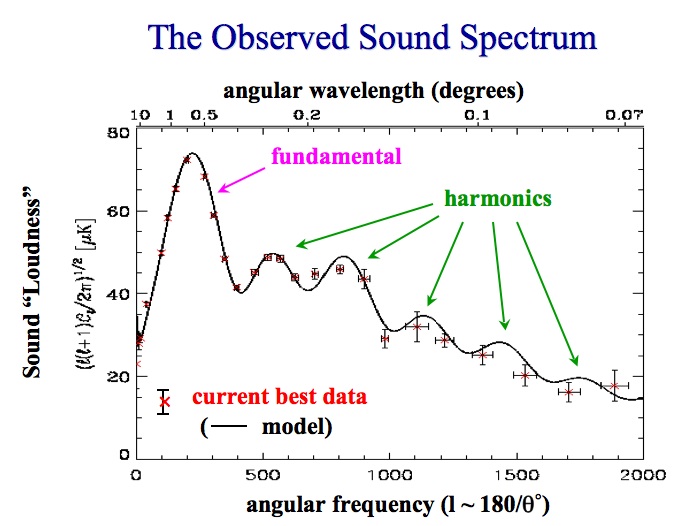
|
It's quite a shock to find out that the sound spectrum of the early Universe is a bit like a vibrating object – it has a fundamental with harmonics! This graph was 10 years in the making, involved many different experiments, and is a holy grail for modern cosmologists. To summarize: the graph shows the relative strength of different sized waves, from those which span the whole sky to little ones, of which 5 could fit under a full moon. Back in the early Universe, this range in wavelength corresponds to 15 million light years for the largest, and 20,000 light years for the smallest. For reasons we'll get to in Topic 13, only waves shorter than 220,000 light years are actually sound waves (angles smaller than ~2°, or l > 50), longer waves than this are a kind of frozen, dormant sound, waiting to awaken. The nature of these longer waves is the subject of Topic 15.
Well, now's the moment we've been waiting for: what does it sound like? First, recall the actual sound is about 50 octaves too low to hear, and we need to transpose it up in pitch by about this amount. The exact up-shift is arbitrary, but I decided to simply swap the angular frequency, l, with the acoustic frequency, f, in Hz. This has several advantages: the fundamental falls at the A below concert A (~220 Hz); the entire range nicely matches a piano; the non-acoustic waves are mostly inaudibly deep; and sounds from yet earlier times can descend from above.
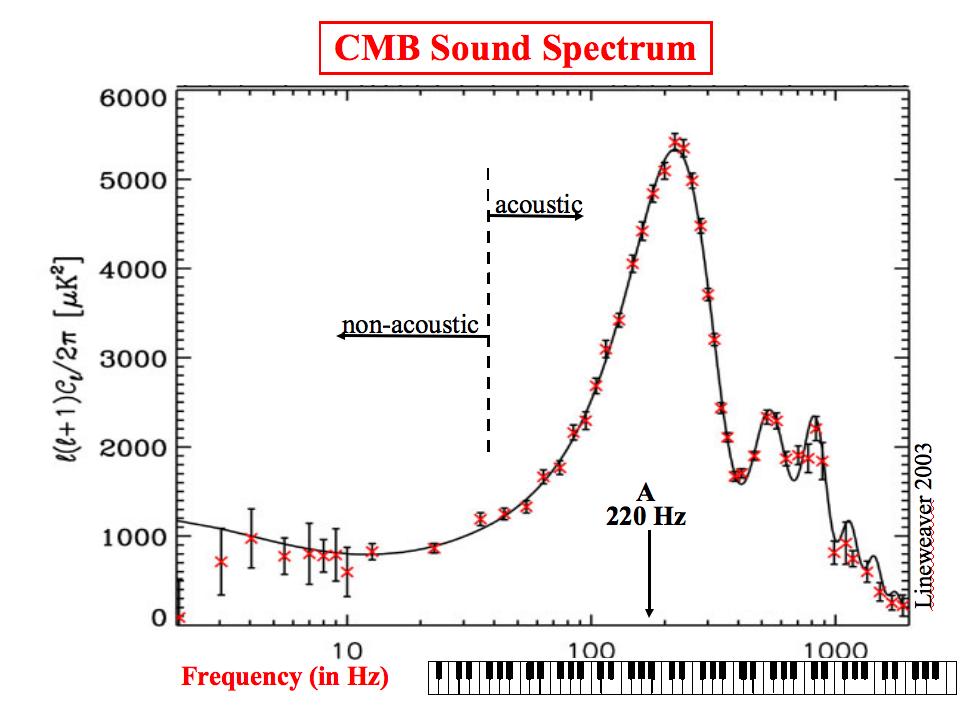
|
Click for sound |
The slide above shows the CMB sound spectrum plotted on an exponential frequency scale, which allows a piano keyboard to be directly superposed. Click on the red speaker to hear the sound. Since this is a single moment in cosmic history, 400,000 years after the Big Bang, the sound is steady and doesn't vary.
Were you disappointed in the CMB sound? To us it seems rather rough and rasping – far from subtle and melodious. But creation's music wasn't written for our ear – it had a much grander plan. As we shall see, for the Universe to be populated by galaxies, stars, atoms and people, the sound needed to have just the character it did. This opening sound contains within it all the richness that is to come.
There are, of course, less poetic reasons the sound is un-musical. With a strong fundamental and harmonics, it is perhaps surprising the sound is not more chord-like. But look again at the power spectrum over the piano keyboard. As a child I liked to push down as many keys my small arms could cover on my father's piano. The fundamental "note" is way too broad to give a simple sound – almost two full octaves "wide". No wonder the sound is a bit coarse.
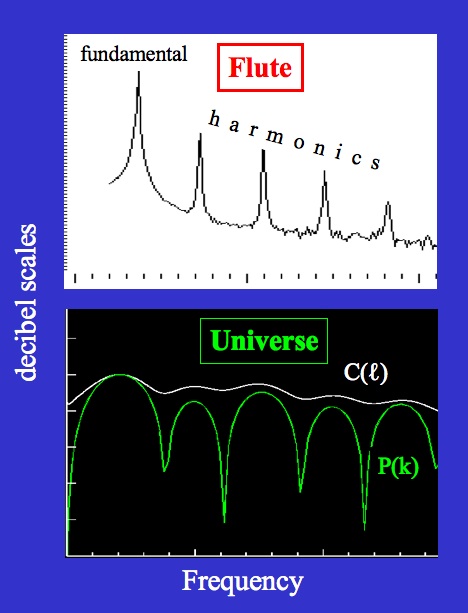
|
Flute: same note (narrow harmonics)
|
The situation is, in fact, both worse and better than this. The slide above shows sound spectra for the CMB and a flute, both plotted on a decibel (logarithmic) loudness scale. Musical instruments are designed to be extremely good resonators: their sound spectra have very narrow peaks at the fundamental and its harmonics – they play "pure" notes. In contrast, the early Universe is a poor musical instrument – its harmonics are so broad one can hardly see them on the decibel plot. Now, as it happens, the CMB signal also contains distortion. But even the un-distorted sound (green line) has broad harmonics. Whatever our preferences might be, the cosmic sounds are going to sound rough to our ears.
The next two slides illustrate, in somewhat different ways, the overall flow of acoustic information from the Big Bang to us. The first just recaps the story so far: the WMAP satellite observes the microwave background with enough sensitivity to trace its patchiness in some detail. The patches we see are sound waves, rather like water waves seen on an ocean surface. Analysis of the patchiness reveals the relative abundance of waves of different wavelength, which yields the famous "CMB sound spectrum". Shifting up by about 50 octaves, we convert the sound spectrum into an audible sound.
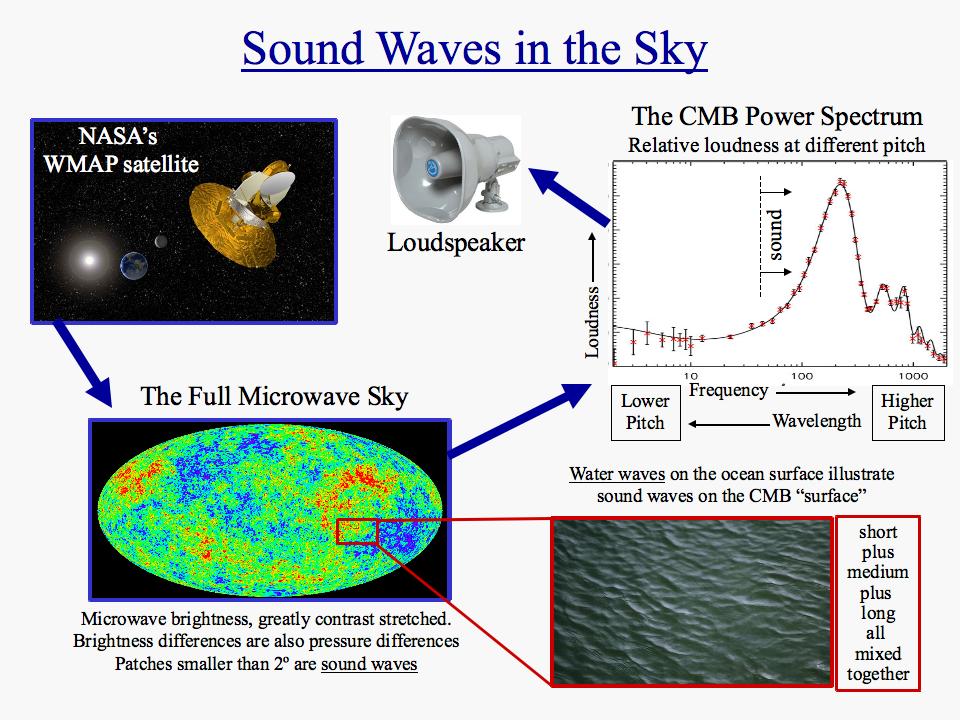
|
The second slide clarifies that we do not hear the sound directly! Sound itself does not move from the Big Bang to us. Instead, the situation is similar to a live music concert. A violin creates sounds which are transformed into radio waves and broadcast to us. Our radio reverses this process, transforming radio waves back into sound. With a few hundred miles between concert and listener, we hear the violin a few microseconds after the fact. Likewise, cosmic sound waves imprint their pattern in a glowing fog. Light from the fog crosses the Universe and arrives at the Earth as microwaves. Telescopes then reconstruct the wave patterns and from these a sound can be produced. The cosmic broadcast is still "live" but because of the huge distance, we hear it 14 billion years after the fact.
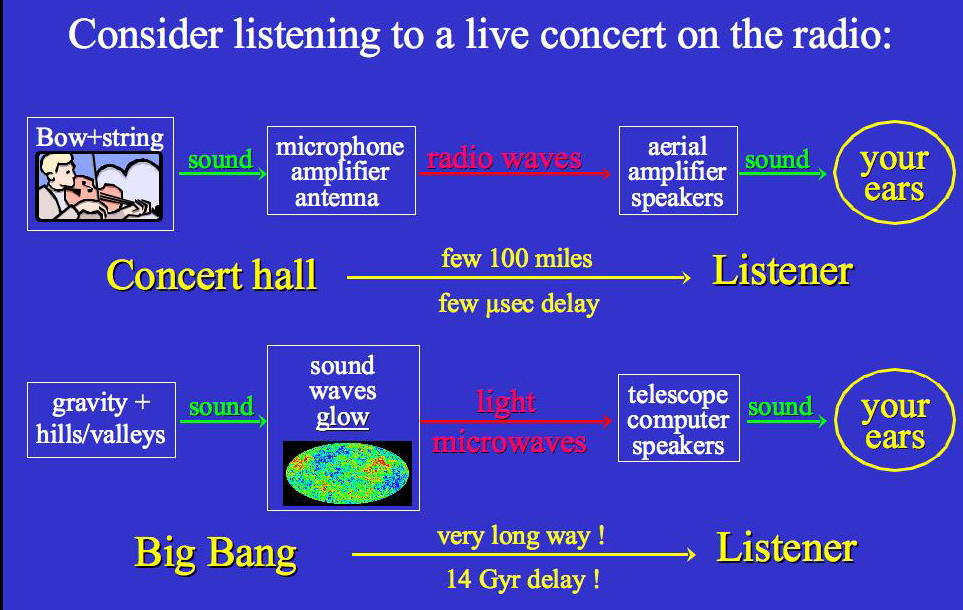
|